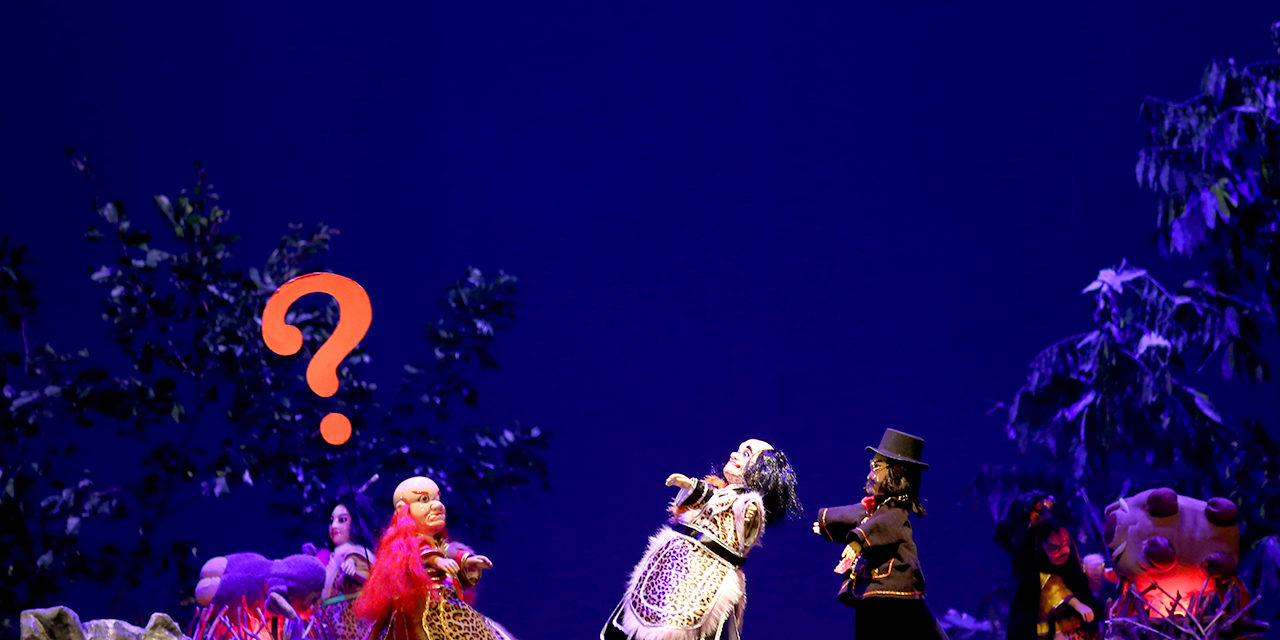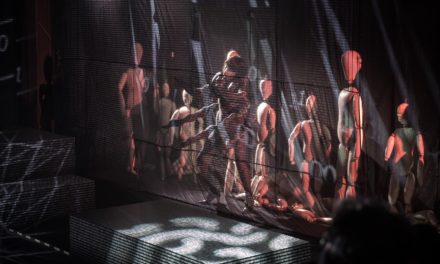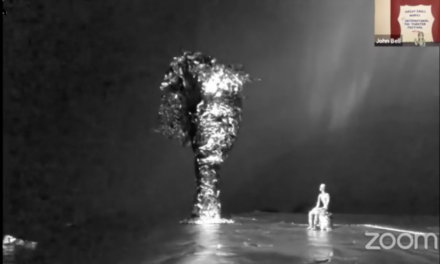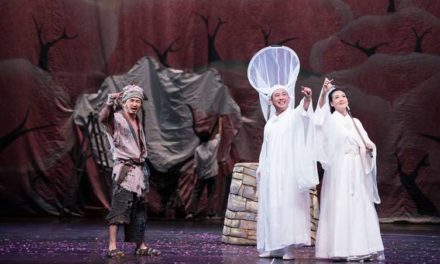Fantasy of the White Snake
Taiwanese hand puppet theatre (also called glove puppetry) originated in the 17th century in local opera performed by puppets in Quanzhou, Mainland China, and Taiwan, and peaked in the “Pili TV Puppet Theatre”—“Yunchou Grand Gracious Knight” series, by Toshio Huang (Huang Chun-Hsiung, 1933–), the son of Taiwan’s national treasure puppet master, Huang Hai-Dai. “Pili TV Puppet Theatre” was a great hit and very popular from 1970 to 1974, but it was eventually forced to cease production because of the political situation. The group’s performances addressed many sensitive political issues and included much innuendo, alluding to political figures such as Chiang Kai-shek and Chiang Ching-Kuo and the conflict with the Mandarin Movement.
No more the small-scale glove puppetry. Now, big puppeteers manipulate puppets with wooden sticks, with an emphasis on the big puppets’ facial expressions as shown on TV, as in the “PiLi TV” puppet drama that Huang invented. Fantasy of The White Snake (Taichung, July 30, 2016), a Taiwanese puppet theater performance by the Jin-Ing Ger Puppet Troupe, innovates nowadays by combining big puppetry with the appearance of the puppeteers on stage, in addition to using TV 3D computer animation.
The computer-assisted animation images, such as a monstrous huge blue snake fighting with a big white crane in the air among the high mountains with clouds floating in the air, are shown on the set by projection. Reversing from TV to return to perform on the proscenium stage in the theater for the more intimate Chinese classic Legend of the White Snake, this modern performance brings local audiences (most are families with young children) a feeling of the here and now as they watch the live performance on the spot in the theatre—a personal, touching experience that, I argue, cannot be replaced by media like TV and film.
The script basically follows the original story of Legend of the White Snake. The puppet female protagonist, Bai Su-Cheng, a good-hearted, tender blue snake fairy with powers after thousands of years of practicing Taoism, is able to transform into a woman. Bai wants to express her gratitude to the male protagonist, Scholar Chang, for saving her life in a previous life when she was a little snake who was almost killed by a river stone. Scholar Chang, in his previous life also as a man, kindly took away the stone, rescuing her. Thus, she descends from the high mountain of the sky where the fairies live to the earth in order to be a mortal woman and marry Chang to thank him in return in this life. Yet their happy marriage ends with a tragedy caused by Monk Fa-Hai, who claims to maintain the traditional conservative ideology—“Humans cannot co-exist with the monsters”—which, I think, is also a kind of Phallo-Orthodoxy, a chauvinism that is not open enough to include the Other.
The puppet masters show great skill in controlling those big puppets to make everyday gestures as if they were real persons —such as drinking tea with small cups in the scene when Scholar Chang, ordered by Monk Fa-Hai, tests whether his wife, Bai Su-Cheng, is really a monster by tricking her into drinking the Hsung-Huang wine—and complicated gestures, such as fighting with different swords. Chen Huang-Bao, the Troupe Head, is the narrator, playing well all of the roles in various tones, and with strong emotions and feelings.
Traditional Taiwanese puppets, manipulated by puppeteers in black and wearing thin black masks, were displayed on a small platform in front of the temples. From the TV puppet shows, this puppet performance now advances to interact with audience members and stage technology with more visual effects in the theater. Although the advertisement claims the performance is a “3D Magical Version,” which may suggest to kids that it employs cinematic 3D effects, this puppet performance is different: it is a live puppet show featuring big, splendid puppets, in which the puppeteers appear front and center, as in the Broadway musicals The Lion King and Warhorse, displaying the physical actions of both puppets and performers. Moreover, this puppetry performance employs modern technology to project images, such as that of the big snake and the big white crane fighting in the air, onto the set’s large screen, as if the audiences were watching a film added with computer-assisted animation. In other words, this performance combines a puppet show, TV visual effects, a cinematic presentation, and the live performance of the performers.
Even so, Fantasy of the White Snake uses the ancient Chinese classical legendary tale but the contemporary Taiwanese puppet theatre performance with “3D Magical Version,” adding a TV spectacle, technology, and editing effects, to achieve a successful adaptation of a puppet theatre performance. It attracts large audiences in the summer, and the audience response is full of appreciation, touching tears, warm applause, and enchantment.
Travel through Time Big Adventure
Yi Hsin-Ge Hands Puppet Theatre Troupe (established in 1953) won the Outstanding Performing Team Award given by Chiayi City, and the Best Music Award of the 9th and 10th Puppet Theatre Golden Palm Prizes in 2015 and 2016 in Taiwan. In a break from the tradition and convention of Taiwanese puppet theatre, Wang Kai-Sheng, producer and spoken parts lead, inherits the family troupe as the fourth generation, performs all of the puppets’ monologues and dialogues on the stage, and plays (electrical and folk) guitar accompanied by a live band with an electric guitar, drums, and electric piano, to innovate as the first Puppet Theatre Rock-and-Roll Musical in Taiwan.
Wang got the idea to take two popular puppet characters (Bushy Handlebar Mustache Lovelorn Man and Primitive Alazi) from his grandfather’s noteworthy puppet theatre series “The Primitive Alazi” to tell the story of their first encounter in the new play Travel through Time Big Adventure. The synopsis of this play is that Bushy Handlebar Mustache Lovelorn Man owns a mystery necklace which his ancestors passed from generation to generation. By accident, a rascal from the future discovers that this necklace is the treasure he has been seeking. Just as the rascal is planning to rob Bushy Handlebar Mustache Lovelorn Man of his necklace, it glows, sucking both of them into the bottomless zone across time and space and back to prehistoric times. In the ancient age, after Handlebar Mustache Lovelorn Man wakes up, he soon makes friends with the primitive boss Alazi and finds the primitive sacrifice custom strange. So he courageously leads the primitive people into the dark forest to figure out what’s going on there. What monster on earth living in the dark forest makes the primitive people fear so much? What surprising encounter does the necklace with mysterious power bring to us?
A hilarious script with many local colloquial puns and references to current events provides audiences, especially kids, a lot of amusement. In initiating the script inspiration, Wang says that he “always likes the phrase ‘Poison wrapped with Sugar.’ Underneath the appearance of happiness, there is a heavy issue; he seeks to express serious, deeply complex issues to audiences with humor. Therefore, he began to observe social phenomena, discovering that nowadays the convenience of technology, instead, results in less physical interaction between human beings than before. He hopes to convey this issue through this play” (Program, p. 3; my translation). As Wang expects that this play can give more people a different understanding and experience of puppet theatre—not just fighting in puppet theatre, no more mere description of the “Underworld.” Puppet theatre offers unlimited performance possibilities. That is what Wang wants to maintain: the “Yi Hsin-Ge Rock-and-Roll Spirit.”
In performance, Wang is innovative in this first attempt to put a live band on stage to accompany the puppeteers manipulating the puppets acting. In so doing, the musicians, who previously supported the performance, now occupy major roles with the puppets, catching audience members’ eyes and capturing their hearts and senses. It is an innovative, interesting, and fun puppet theatre performance with a live rock & roll band on stage. The script is full of humor to arouse the audience members’ laughter. Most of the audience members are families with kids.
The two puppet theatre performances feature some excellent acting, great sets with the assistance of technology and 3D TV animation projection, and solid puppeteers’ skills in manipulating the either big or small puppets as if the puppets were real people, carrying weapons, fighting, and making all kinds of everyday gestures, such as drinking, dancing, and holding umbrellas. They feature keen directing and satisfying mise-en-scène, aided by modern technology and innovation to fascinate audiences with superior scripts (the former an adaptation, the latter original) with imagination from the ancient to the future, and back to the contemporary, traveling through time and space.
Fantasy of the White Snake. Troupe Head & Single Narrator Chen Huang-Bao. Playwright & Director Chen Chien-Yi. Jin-Ing-Ger Puppet Troupe. Taichung: Taichung Performing Center, July 30, 2016.
Travel through Time Big Adventure. Playwright & Director Huang Chiao-Wei. Producer & Single Narrator Wang Kai-Sheng. Yi Hsin-Ge Hands Puppet Theatre Troupe. Chia-Yi City Performing Arts Center, August 27, 2016.
This post was written by the author in their personal capacity.The opinions expressed in this article are the author’s own and do not reflect the view of The Theatre Times, their staff or collaborators.
This post was written by Iris Hsin-chun Tuan.
The views expressed here belong to the author and do not necessarily reflect our views and opinions.


















